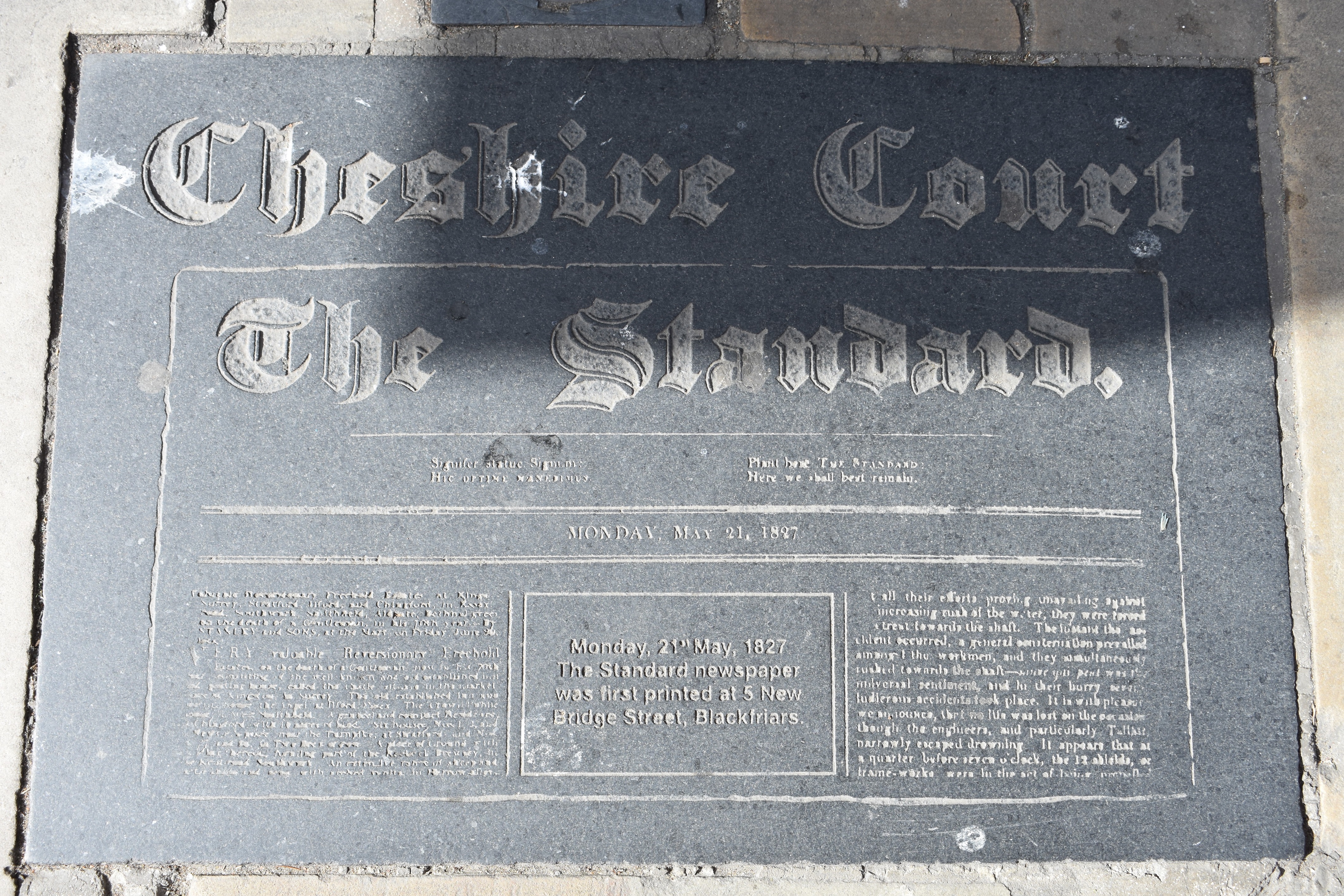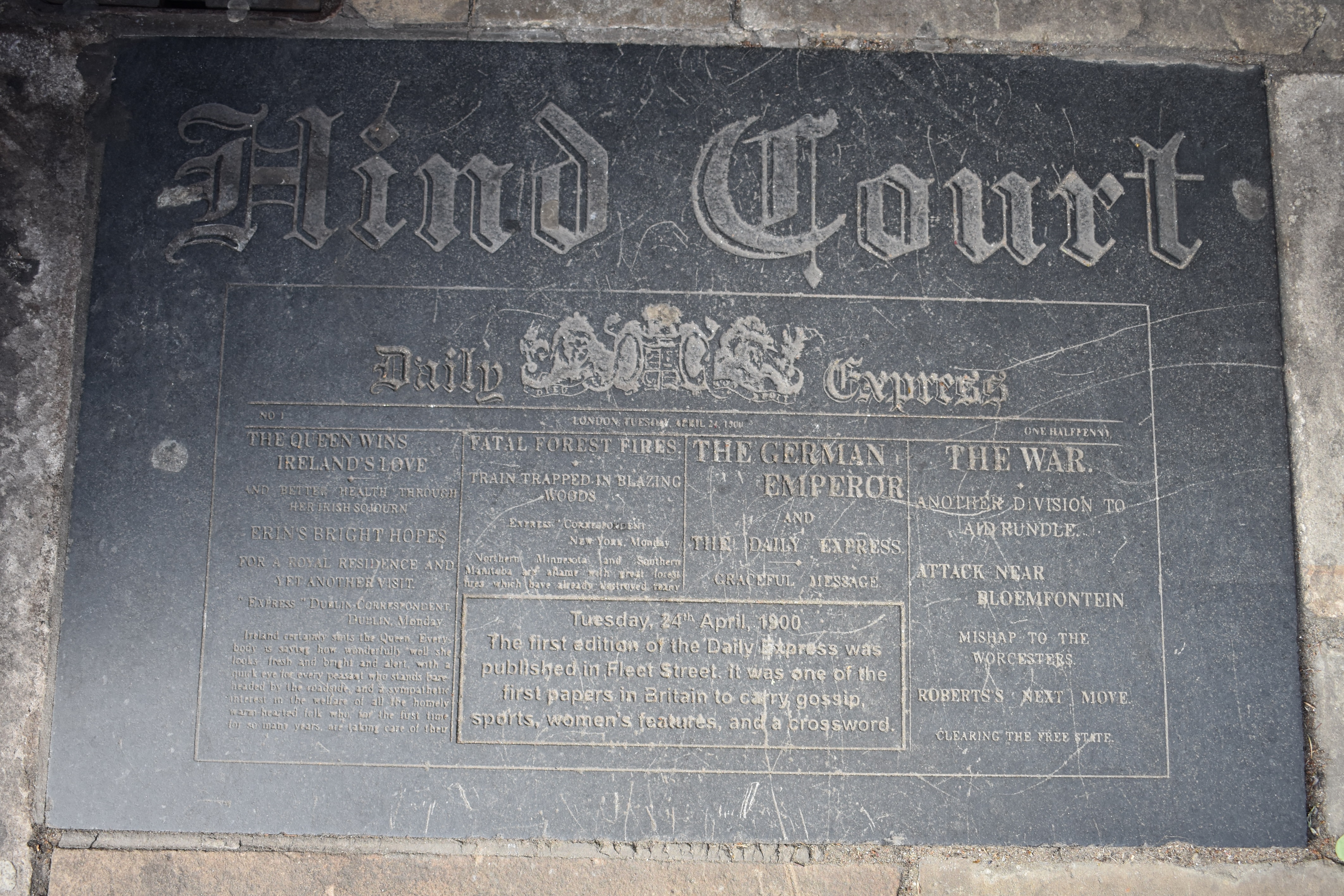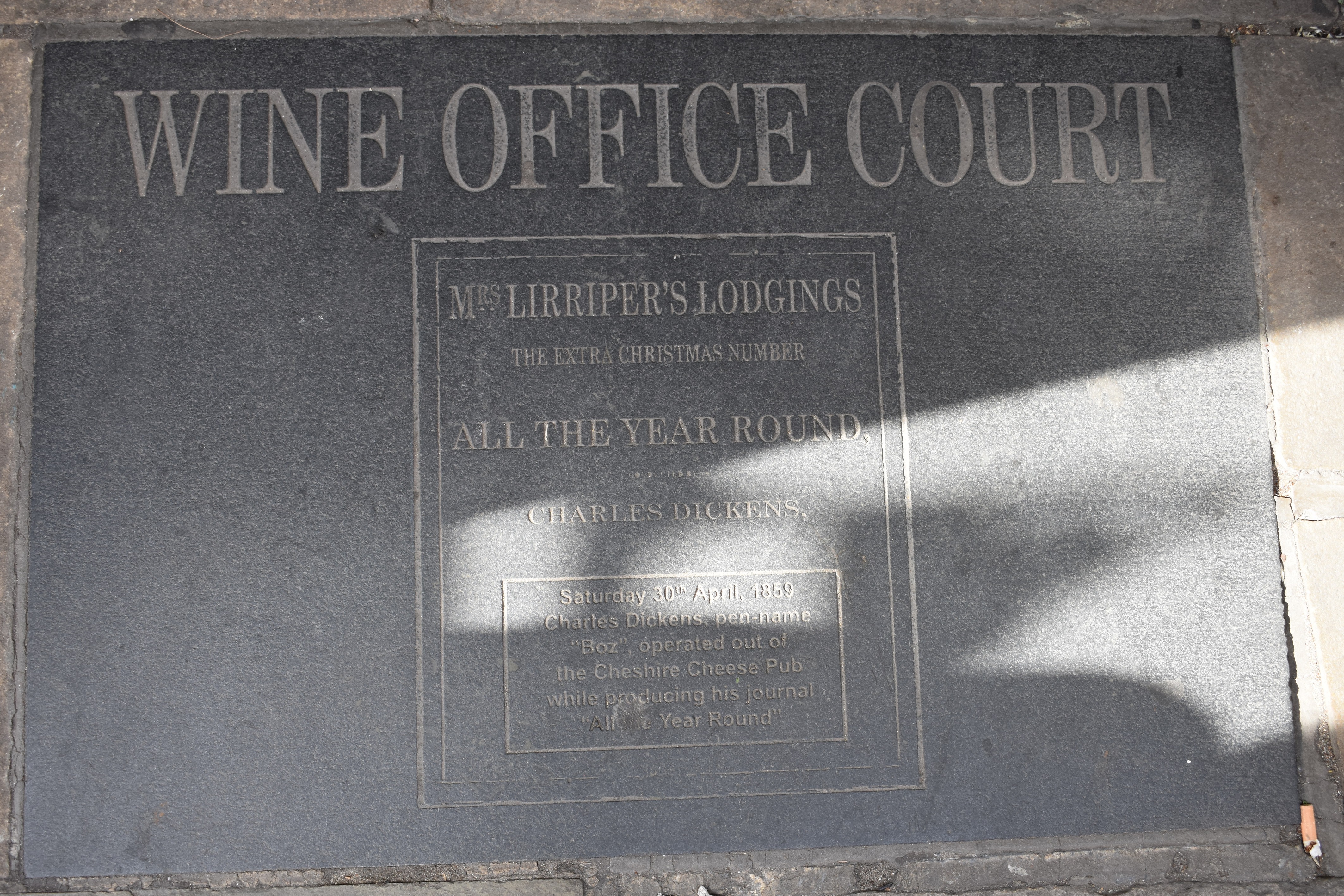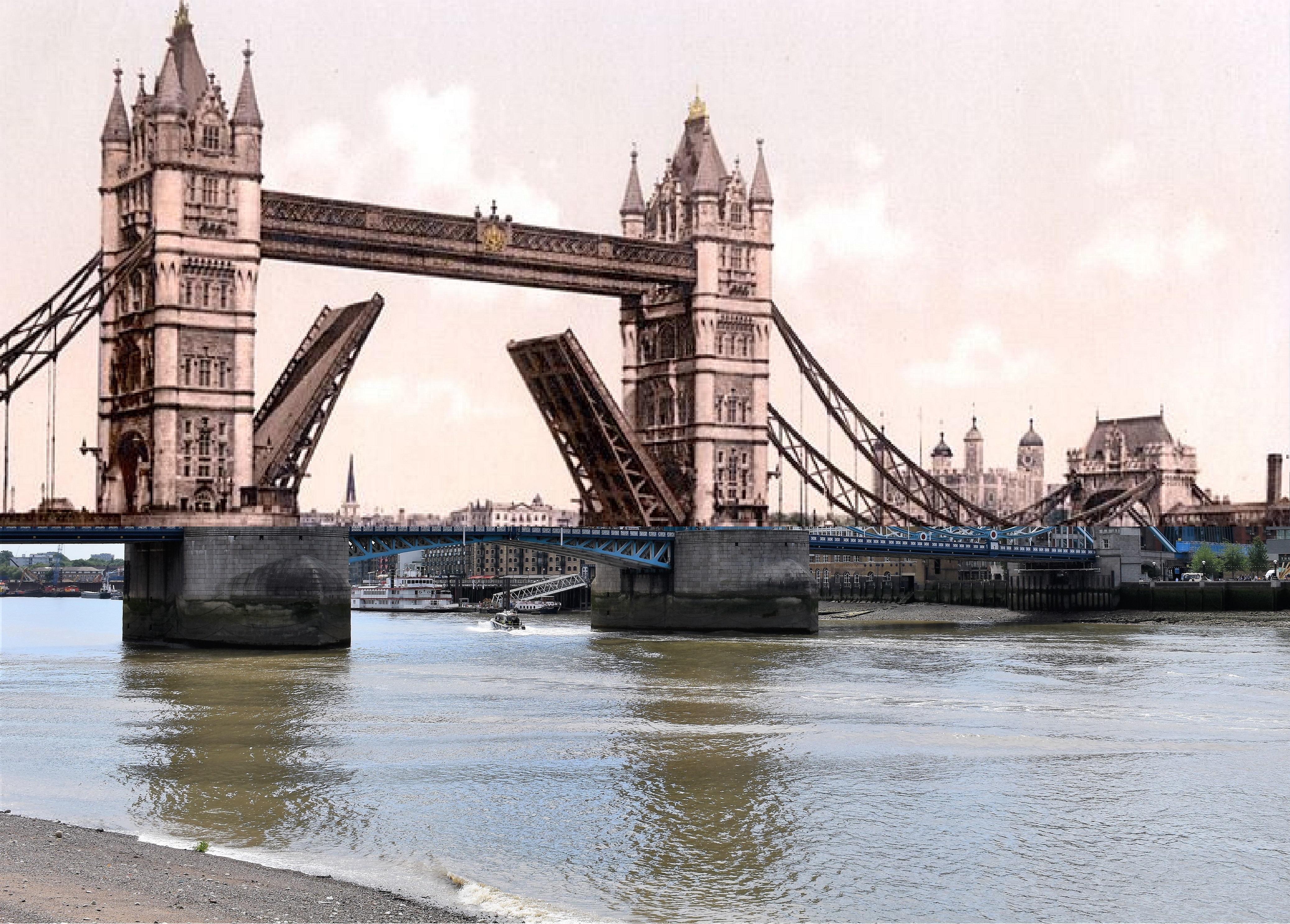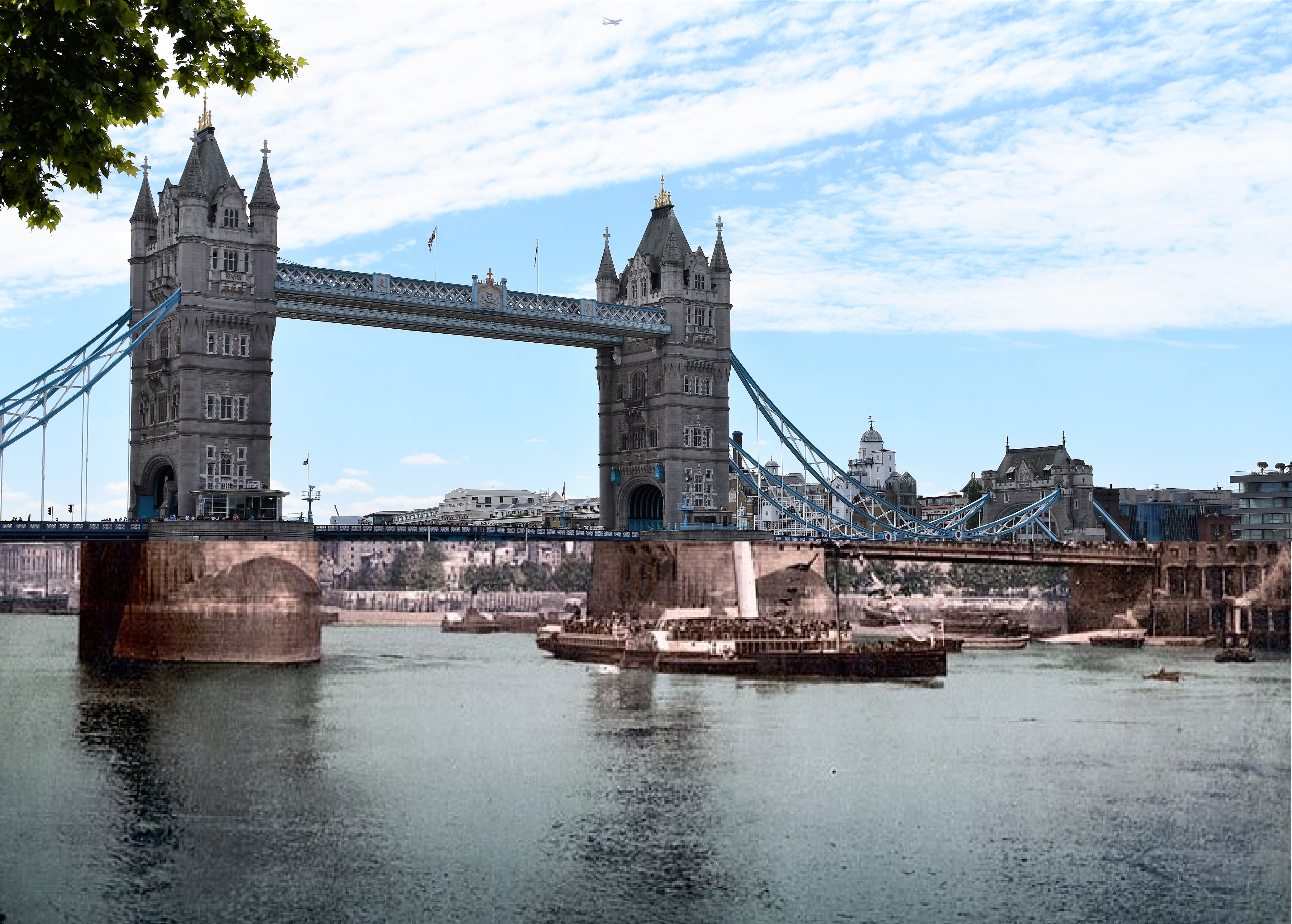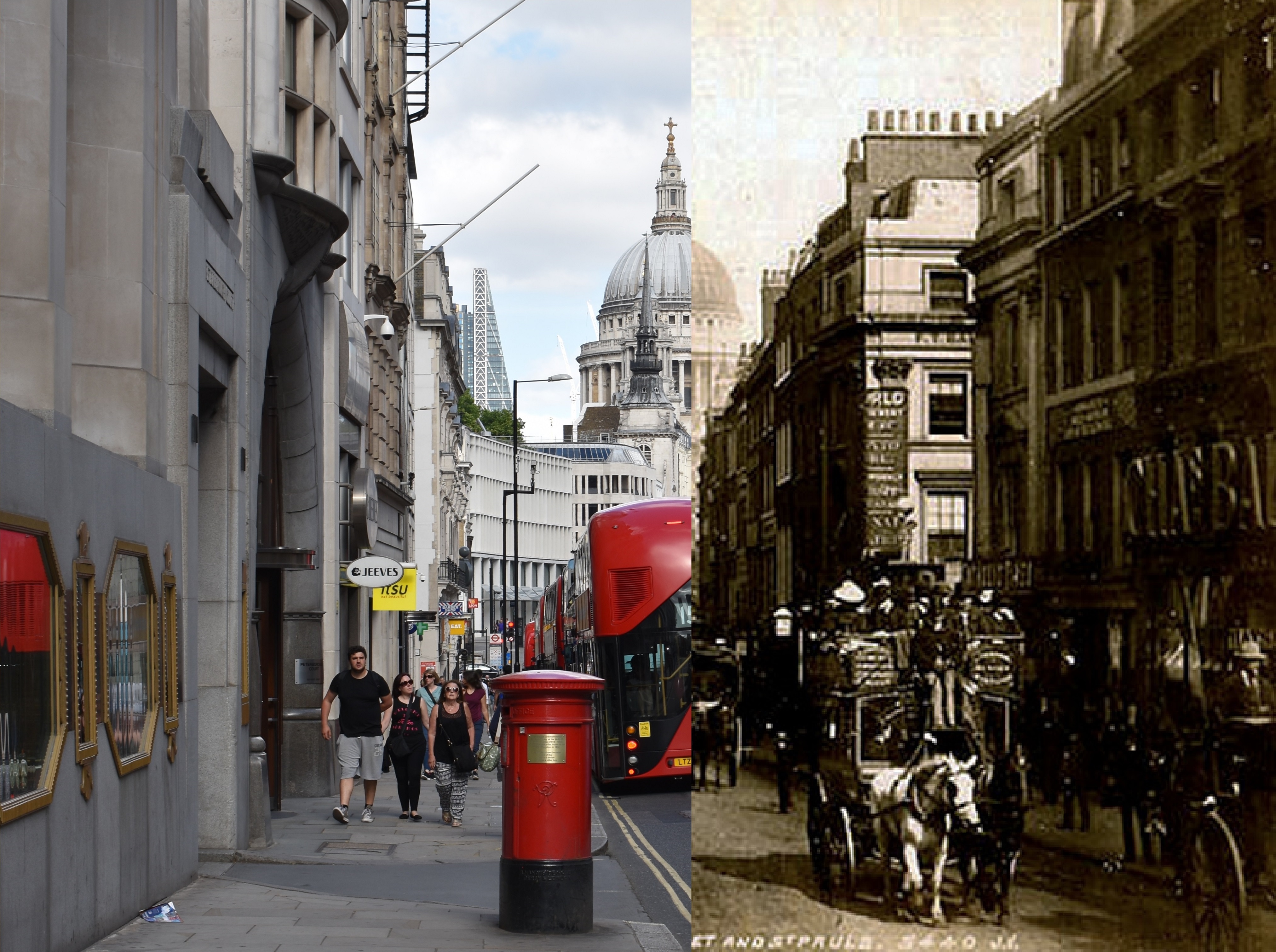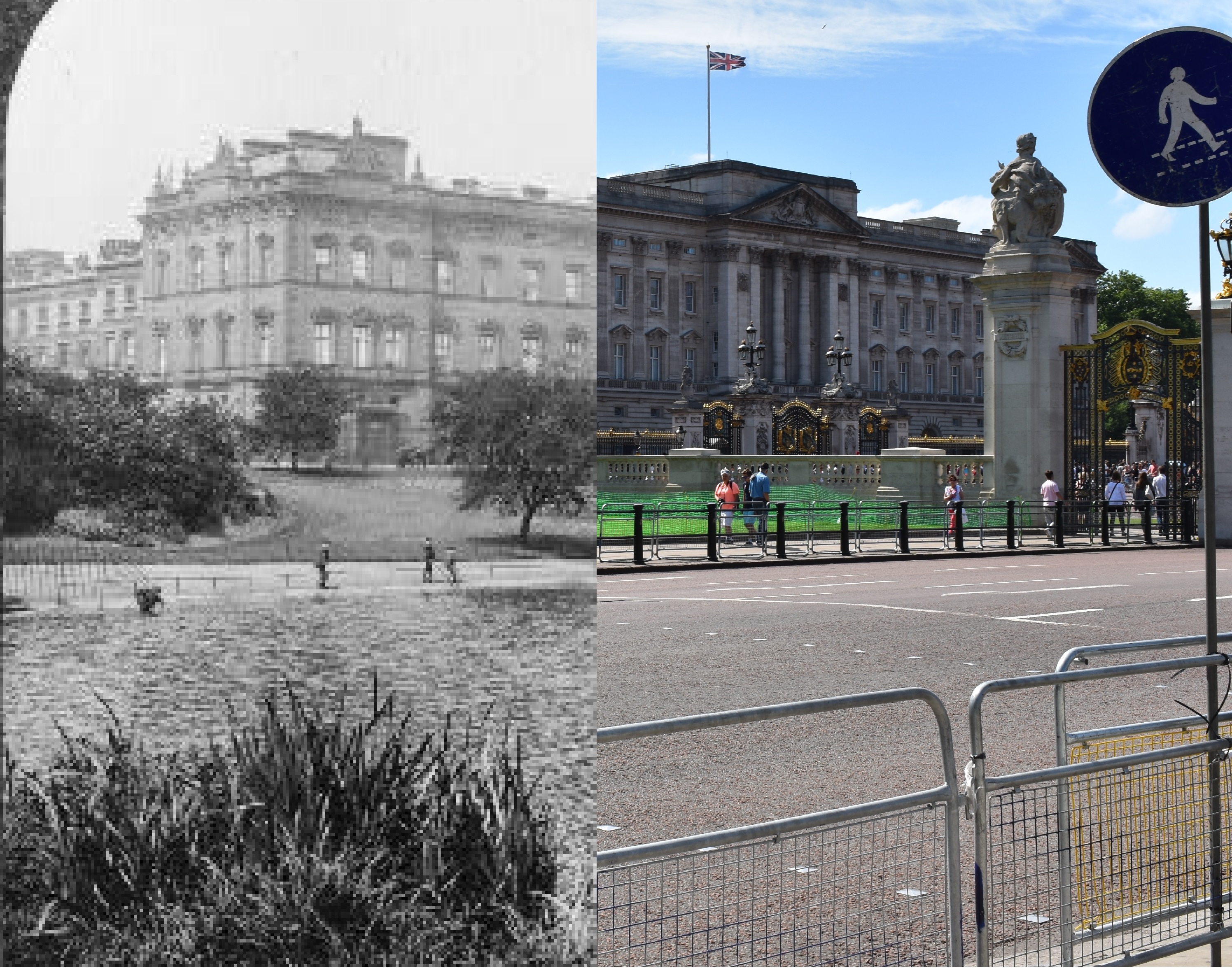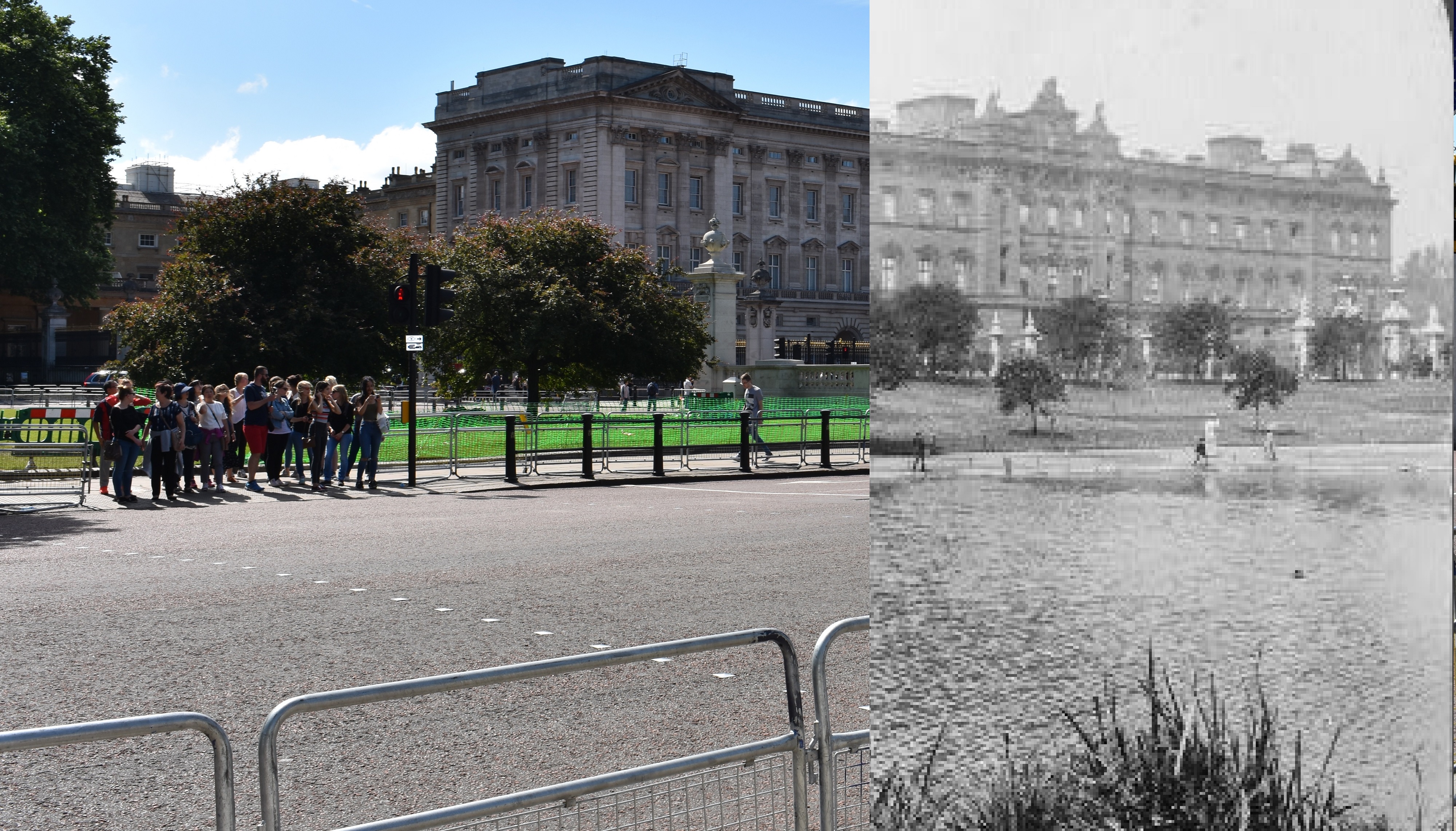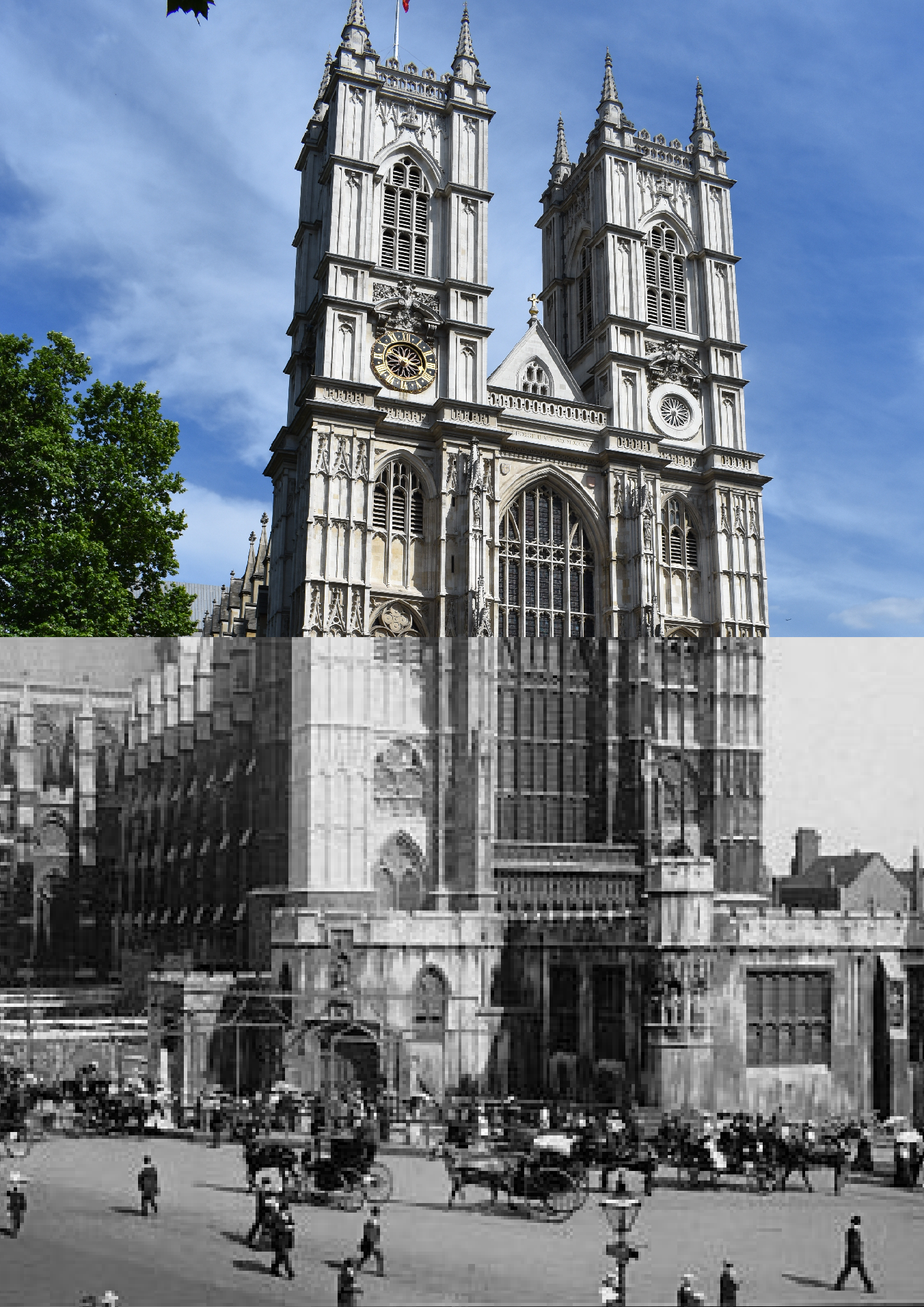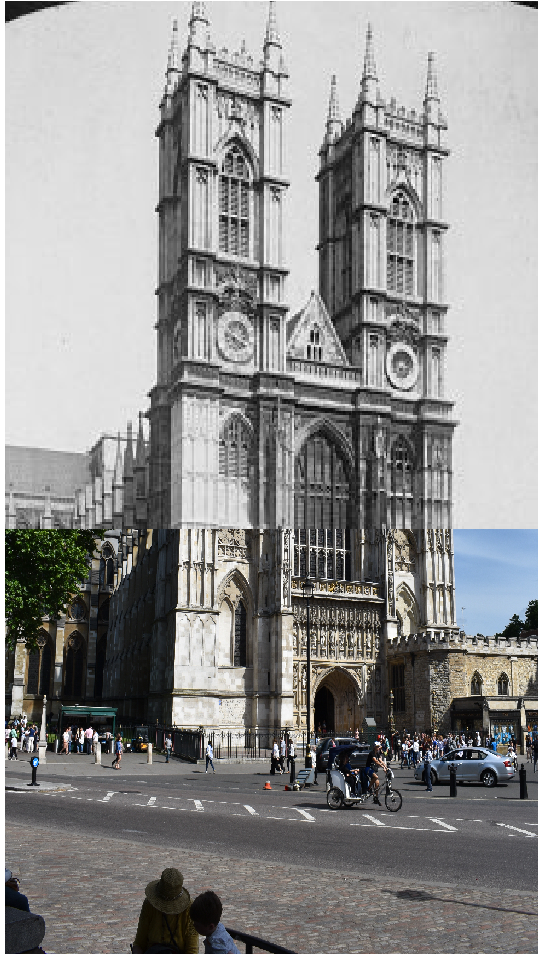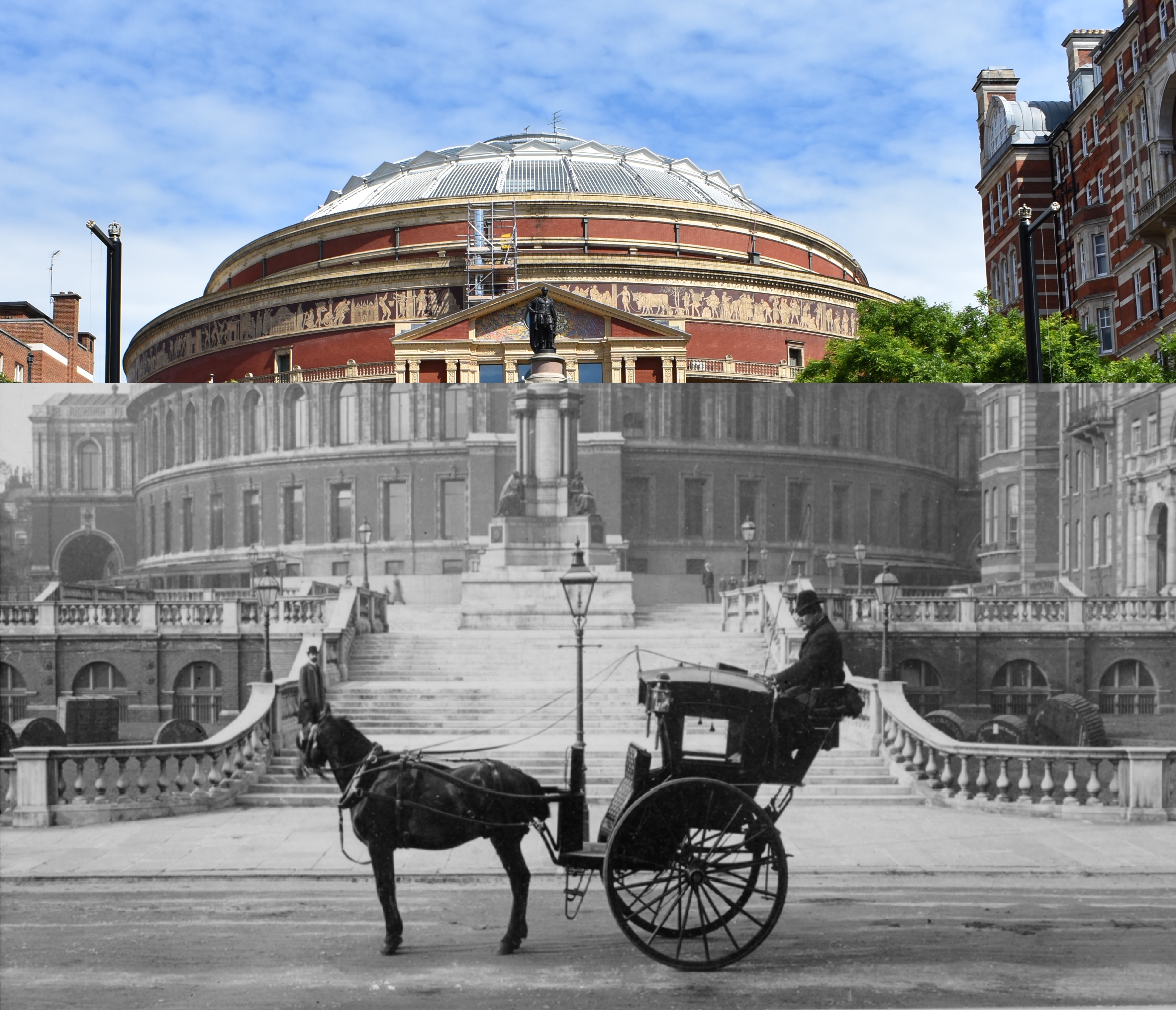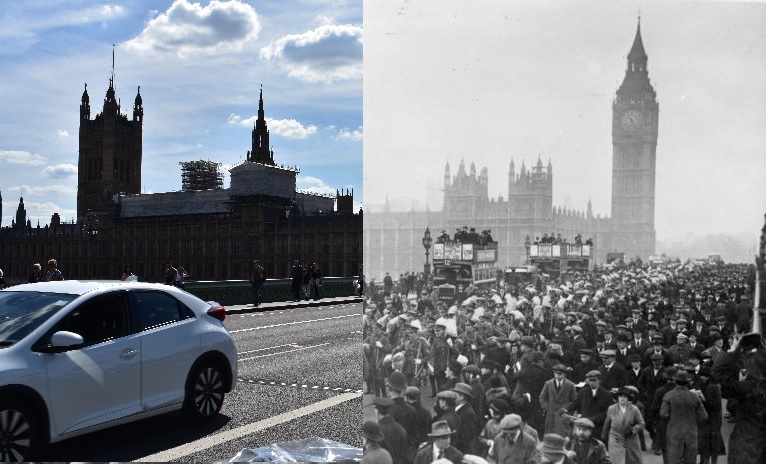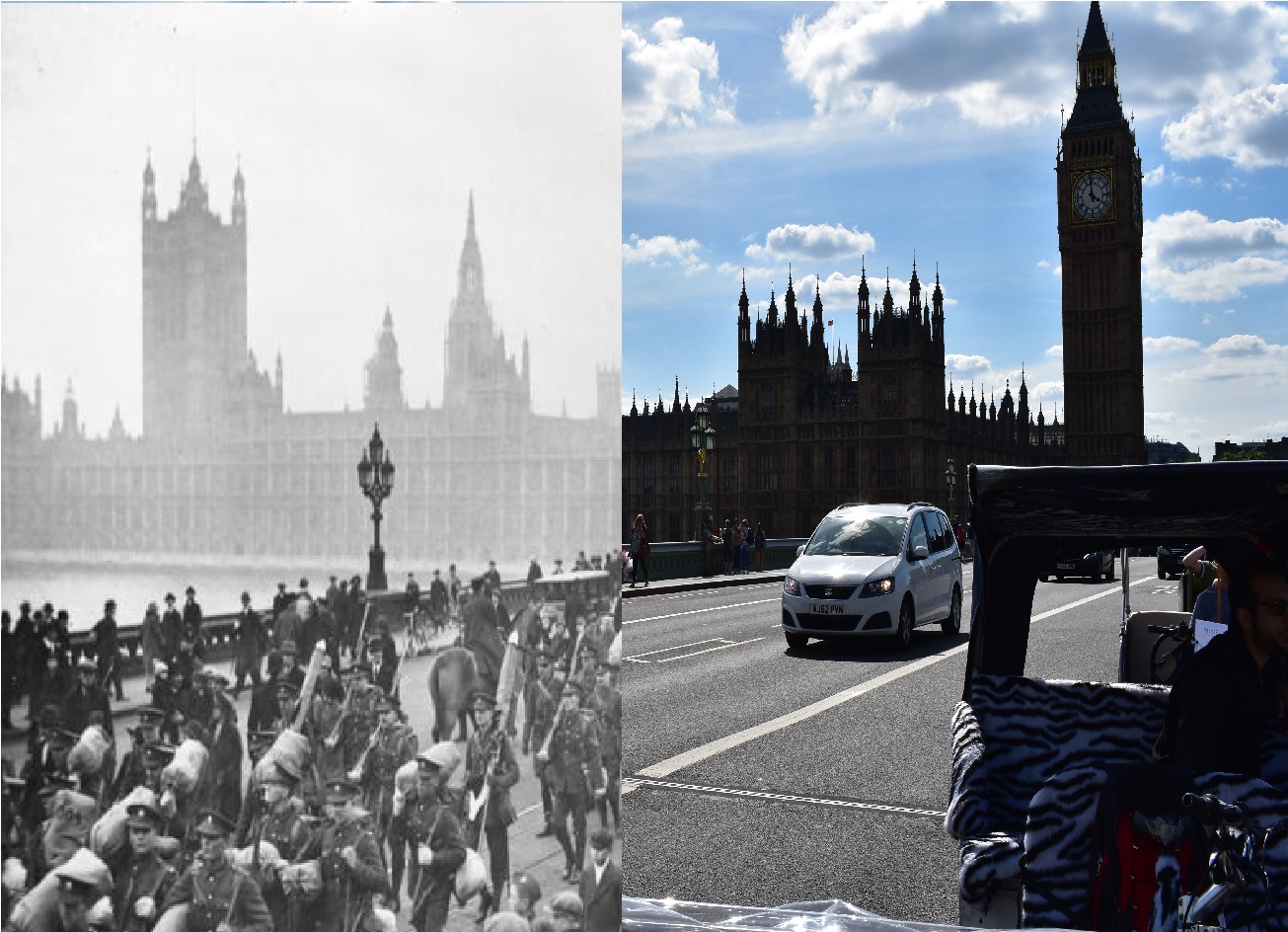Difference between revisions of "London: Past v. Present"
From Londonhua WIKI
(→Big Ben) |
(→Westminster Abbey) |
||
| Line 66: | Line 66: | ||
==Westminster Abbey== | ==Westminster Abbey== | ||
| − | Presently, Westminster Abbey is one of the most renowned churches in England, if not the world. It is a huge tourist attraction and the subject of many historical inquiries. But, what was it like 100 years ago? Were people as interested in the history of the building as they are now? Well, in 1907, a music journal titled ''The Music Times'' published four issues of their journal each containing an article about music in the Abbey<ref name = "Crotchet"> [http://www.jstor.org.ezproxy.wpi.edu/stable/pdf/903538.pdf], Crotchet, D. (1907). Westminster Abbey. The Musical Times, 48(770), 221-227. doi:10.2307/903538. Retrieved from JSTOR </ref>. These articles show how esteemed the Abbey was during the early 20th century. The author of the articles states "of all the beautiful cathedrals and abbeys in this fair land of ours none can compare with the stately fane of Westminster"<ref name = "Crotchet"/>. It is not surprising that Westminster Abbey was a focal point of research 100 years ago seeing as the church was first built over 900 years ago. It is surprising, however, how infatuated with the Abbey Crotchet seemed to be saying the church built on the command of Edward the Confessor was "the first Abbey worthy of the name of Westminster"<ref name = "Crotchet"/>. It is clear that Westminster Abbey is still a well-respected venue, the emphasis being on still. Crotchet was not the only one who believed the Abbey to be a place worthy of admiration. An article in ''The British Medical Journal'' written by a graduate of Edinburgh in 1871 used the terms "venerable", "illustrious", and 'honoured" to describe the church and the people buried there in a request for a bust of Lord Lister to be present in the Abbey<ref name = "Lister"> [http://www.jstor.org.ezproxy.wpi.edu/stable/25296308?Search=yes&resultItemClick=true&searchText=westminster&searchText=abbey&searchUri=%2Faction%2FdoAdvancedSearch%3Fed%3D1915%26amp%3Bsd%3D1900%26amp%3Bc2%3DAND%26amp%3Bc1%3DAND%26amp%3Bf1%3Dall%26amp%3Bf0%3Dall%26amp%3Bacc%3Don%26amp%3BresultsServiceName%3DdoBackToBasicResults%26amp%3Bbk%3Don%26amp%3Brefreqid%3Dexcelsior%253A03a52b82debbcd8b39cb07f6a48c77b7%26amp%3Bq0%3Dwestminster%2Babbey%26amp%3Bc4%3DAND%26amp%3Brr%3Don%26amp%3Bf2%3Dall%26amp%3Bc6%3DAND%26amp%3Bc3%3DAND%26amp%3Bf5%3Dall%26amp%3Bf6%3Dall%26amp%3Bc5%3DAND%26amp%3Bf3%3Dall%26amp%3Bar%3Don%26amp%3Bgroup%3Dcontrol%26amp%3Bf4%3Dall&refreqid=search%3A53c191957c90f7b21a9ccd59aa43d8b4&seq=1#page_scan_tab_contents], An Edinburgh Graduate of 1871. (1912). Lord Lister And Westminster Abbey. The British Medical Journal, 1(2670), 523-523. Retrieved from JSTOR </ref>. <br><br> | + | Presently, Westminster Abbey is one of the most renowned churches in England, if not the world. It is a huge tourist attraction and the subject of many historical inquiries. But, what was it like 100 years ago? Were people as interested in the history of the building as they are now? Well, in 1907, a music journal titled ''The Music Times'' published four issues of their journal each containing an article about music in the Abbey<ref name = "Crotchet"> [http://www.jstor.org.ezproxy.wpi.edu/stable/pdf/903538.pdf], Crotchet, D. (1907). Westminster Abbey. The Musical Times, 48(770), 221-227. doi:10.2307/903538. Retrieved from JSTOR </ref>. These articles show how esteemed the Abbey was during the early 20th century. The author of the articles states "of all the beautiful cathedrals and abbeys in this fair land of ours none can compare with the stately fane of Westminster"<ref name = "Crotchet"/>. It is not surprising that Westminster Abbey was a focal point of research 100 years ago seeing as the church was first built over 900 years ago. It is surprising, however, how infatuated with the Abbey Crotchet seemed to be, saying the church built on the command of Edward the Confessor was "the first Abbey worthy of the name of Westminster"<ref name = "Crotchet"/>. It is clear that Westminster Abbey is still a well-respected venue, the emphasis being on still. Crotchet was not the only one who believed the Abbey to be a place worthy of admiration. An article in ''The British Medical Journal'' written by a graduate of Edinburgh in 1871 used the terms "venerable", "illustrious", and 'honoured" to describe the church and the people buried there in a request for a bust of Lord Lister to be present in the Abbey<ref name = "Lister"> [http://www.jstor.org.ezproxy.wpi.edu/stable/25296308?Search=yes&resultItemClick=true&searchText=westminster&searchText=abbey&searchUri=%2Faction%2FdoAdvancedSearch%3Fed%3D1915%26amp%3Bsd%3D1900%26amp%3Bc2%3DAND%26amp%3Bc1%3DAND%26amp%3Bf1%3Dall%26amp%3Bf0%3Dall%26amp%3Bacc%3Don%26amp%3BresultsServiceName%3DdoBackToBasicResults%26amp%3Bbk%3Don%26amp%3Brefreqid%3Dexcelsior%253A03a52b82debbcd8b39cb07f6a48c77b7%26amp%3Bq0%3Dwestminster%2Babbey%26amp%3Bc4%3DAND%26amp%3Brr%3Don%26amp%3Bf2%3Dall%26amp%3Bc6%3DAND%26amp%3Bc3%3DAND%26amp%3Bf5%3Dall%26amp%3Bf6%3Dall%26amp%3Bc5%3DAND%26amp%3Bf3%3Dall%26amp%3Bar%3Don%26amp%3Bgroup%3Dcontrol%26amp%3Bf4%3Dall&refreqid=search%3A53c191957c90f7b21a9ccd59aa43d8b4&seq=1#page_scan_tab_contents], An Edinburgh Graduate of 1871. (1912). Lord Lister And Westminster Abbey. The British Medical Journal, 1(2670), 523-523. Retrieved from JSTOR </ref>. <br><br> |
Popular opinion of the Abbey in the early 1900s is massivley on the positive side and it doesn't seem to have changed much. Westminster is still the focus of many researchers in fields of history, art, music and many more. In his book about Edward the Confessor, Eric Fernie dedicates an entire chapter to Westminster Abbey saying it "has a good claim to being the most important building project of his reign"<ref name = "Edward"> [http://www.jstor.org.ezproxy.wpi.edu/stable/pdf/10.7722/j.ctt163tbc2.13.pdf?refreqid=excelsior%3Ab3a484818373ba48daa024ac8b885910], Fernie, E. (2009). Edward the Confessor’s Westminster Abbey. In MORTIMER R. (Ed.), Edward the Confessor: The Man and the Legend (pp. 139-150). Boydell and Brewer. Retrieved from JSTOR</ref>. Fernie goes on to explain the architecture and construction of the building before it was knocked down in 1245 for Henry III's new church<ref name = "Edward"/>. Other historians have examined different aspects of the church's history. Ian Atherton examined the connection cathedrals have to the reformation in an article in ''The Historic Journal'' <ref> [http://www.jstor.org.ezproxy.wpi.edu/stable/40930362], ATHERTON, I. (2010). CATHEDRALS, LAUDIANISM, AND THE BRITISH CHURCHES. The Historical Journal, 53(4), 895-918. Retrieved from JSTOR </ref>. He describes the multiple viewpoints historians have about the role of cathedrals in post-reformationn England and why so many focus on Westminster Abbey. Another aspect of modern studies about the Abbey revolve around art and filmography. The journal article "Using Popular Film in the Architectural History Classroom", Rumiko Handa describes the increase in the use of actual buildings for film and describes Westminste Abbey as an "already popular" site<ref name = "Film"> [www.jstor.org/stable/10.1525/phr.2009.78.3.367], Handa, R. (2010). Using Popular Film in the Architectural History Classroom. Journal of the Society of Architectural Historians, 69(3), 311-319. doi:10.1525/phr.2009.78.3.367 </ref> Handa goes on to explain the differences between Westminster and York Minster, the church used to film the coronation scene in ''Elizabeth'' <ref name = "Film"/>. One difference she mentions is the triforiums in the two buildings. Westminster has a | Popular opinion of the Abbey in the early 1900s is massivley on the positive side and it doesn't seem to have changed much. Westminster is still the focus of many researchers in fields of history, art, music and many more. In his book about Edward the Confessor, Eric Fernie dedicates an entire chapter to Westminster Abbey saying it "has a good claim to being the most important building project of his reign"<ref name = "Edward"> [http://www.jstor.org.ezproxy.wpi.edu/stable/pdf/10.7722/j.ctt163tbc2.13.pdf?refreqid=excelsior%3Ab3a484818373ba48daa024ac8b885910], Fernie, E. (2009). Edward the Confessor’s Westminster Abbey. In MORTIMER R. (Ed.), Edward the Confessor: The Man and the Legend (pp. 139-150). Boydell and Brewer. Retrieved from JSTOR</ref>. Fernie goes on to explain the architecture and construction of the building before it was knocked down in 1245 for Henry III's new church<ref name = "Edward"/>. Other historians have examined different aspects of the church's history. Ian Atherton examined the connection cathedrals have to the reformation in an article in ''The Historic Journal'' <ref> [http://www.jstor.org.ezproxy.wpi.edu/stable/40930362], ATHERTON, I. (2010). CATHEDRALS, LAUDIANISM, AND THE BRITISH CHURCHES. The Historical Journal, 53(4), 895-918. Retrieved from JSTOR </ref>. He describes the multiple viewpoints historians have about the role of cathedrals in post-reformationn England and why so many focus on Westminster Abbey. Another aspect of modern studies about the Abbey revolve around art and filmography. The journal article "Using Popular Film in the Architectural History Classroom", Rumiko Handa describes the increase in the use of actual buildings for film and describes Westminste Abbey as an "already popular" site<ref name = "Film"> [www.jstor.org/stable/10.1525/phr.2009.78.3.367], Handa, R. (2010). Using Popular Film in the Architectural History Classroom. Journal of the Society of Architectural Historians, 69(3), 311-319. doi:10.1525/phr.2009.78.3.367 </ref> Handa goes on to explain the differences between Westminster and York Minster, the church used to film the coronation scene in ''Elizabeth'' <ref name = "Film"/>. One difference she mentions is the triforiums in the two buildings. Westminster has a | ||
Revision as of 16:06, 15 June 2017
London: Past v. Present
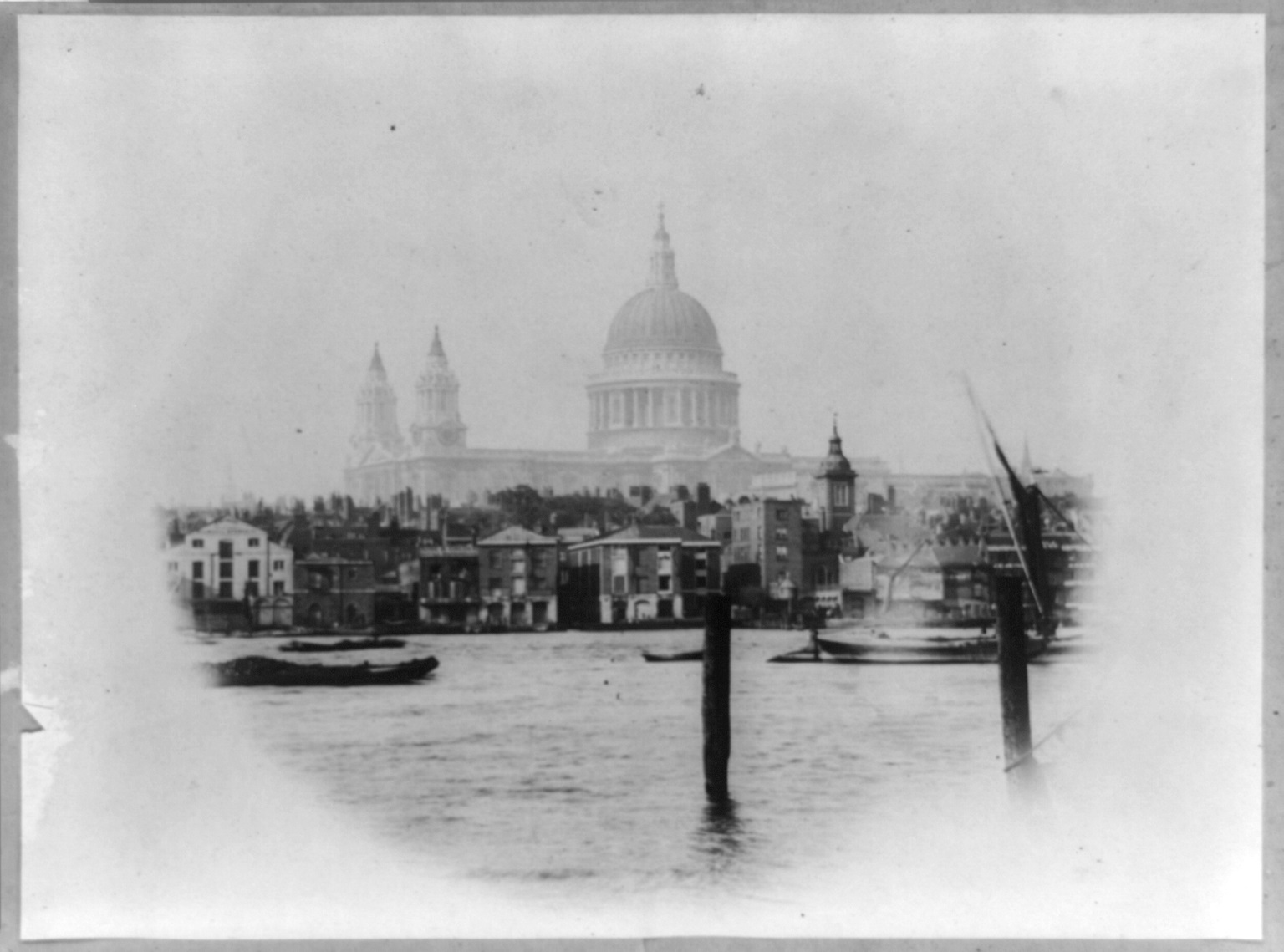 St. Paul's Cathedral circa 1852 [1] | |
| Photo Credit | Unknown |
|---|---|
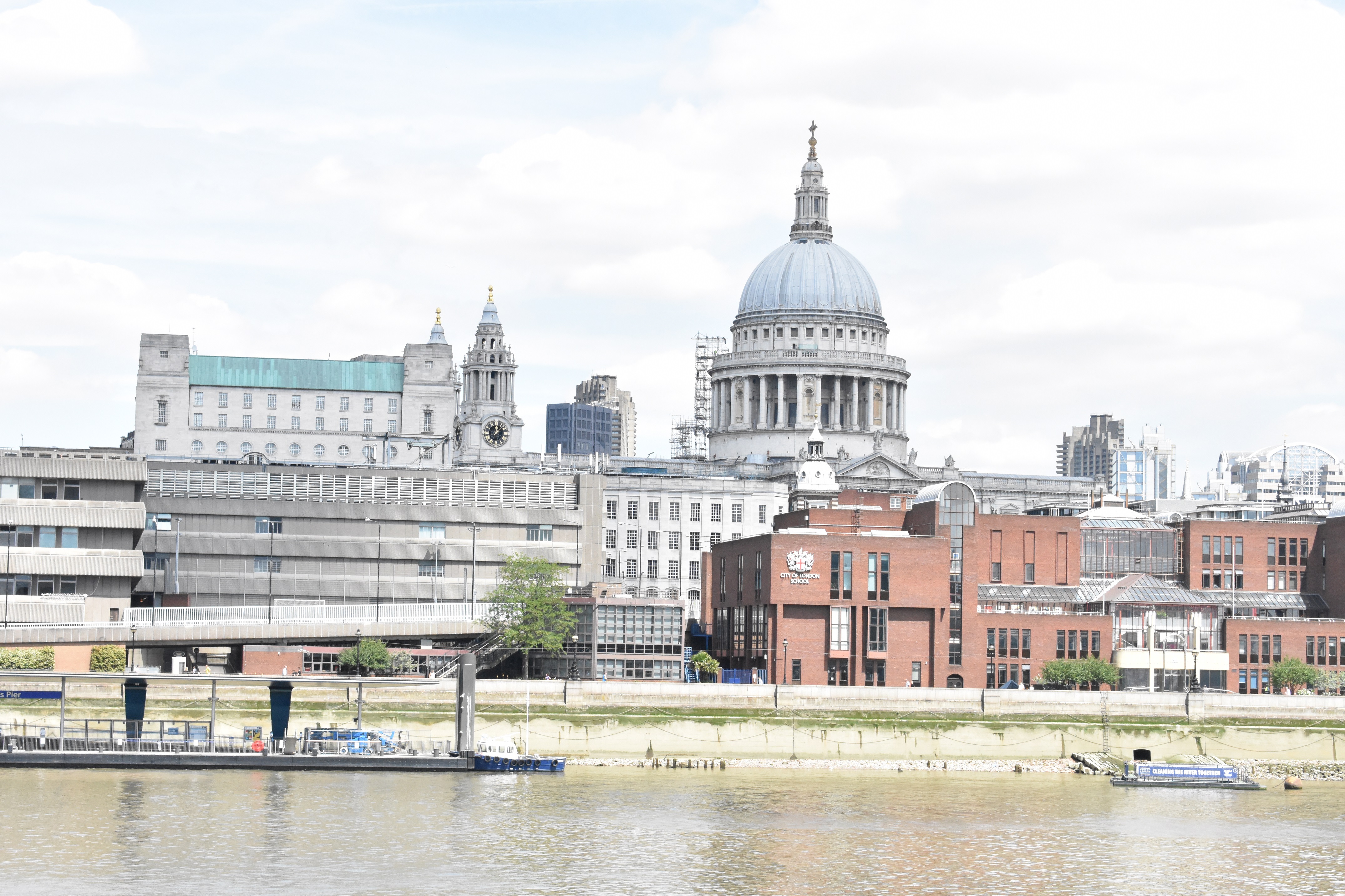 St. Paul's Cathedral 2017 | |
| Photo Credit | Trinity Tedtsen |
|---|---|
Contents
Abstract
Throughout this project, I wanted to explore what has changed about some of London's most famous structures and the surrounding areas. London is a city rich in history, my humanities focus, and I wanted to do something different with that. With that in mind, I decided to do a photography project focused on comparing London to what it looked like 100 years ago. In completing this milestone, I have discovered three main concepts. One, the buildings' physical appearances have changed very little to preserve history. Two, the purpose of these structures have changed, some buildings more drastically than others. And three, technology is much more relevant to our society today than it was 100 years ago.
Introduction
I suggest you save this section for last. Describe the essence of this project. Cover what the project is and who cares in the first two sentences. Then cover what others have done like it, how your project is different. Discuss the extent to which your strategy for completing this project was new to you, or an extension of previous HUA experiences.
As you continue to think about your project milestones, reread the "Goals" narrative on defining project milestones from the HU2900 syllabus. Remember: the idea is to have equip your milestone with a really solid background and then some sort of "thing that you do". You'll need to add in some narrative to describe why you did the "thing that you did", which you'd probably want to do anyway. You can make it easy for your advisors to give you a high grade by ensuring that your project milestone work reflects careful, considerate, and comprehensive thought and effort in terms of your background review, and insightful, cumulative, and methodical approaches toward the creative components of your project milestone deliverables.
Background
Tower Bridge
Tower Bridge was built to help handle the massive amounts of both vehicular and pedestrian traffic crossing London Bridge each day. Between 1874 and 1885 about thirty public bodies petitioned the authorities to either widen London Bridge or build a new one altogether. Many proposals were considered by an appointed committee, these include low bridges with swing openings for ships, high bridges with inclined roadways approaching the river, and railways or ferry boats to transport goods around the bridge. These proposals were all rejected. In 1878 Horace Jones, the City Architect at the time, proposed a low-level bascule type bridge. This type of bridge had been successfully completed prior to Tower Bridge, but on much smaller scales. Jones's proposal was accepted and the structure is still standing today.
Building the Bridge
In 1885, an Act of Parliament allowing the Corporation of the City of London to build the bridge was passed. John Wolfe Barry was dubbed engineer and Jones was appointed architect, but died later that year [2]. Eight contractors divided the work of actually constructing the bridge. John Jackson was responsible for the piers and abutments, William Arrol the steel superstructure, W. G. Armstong and Mitchell and CO, Ltd, for the hydraulic machinery, and Perry and Company for the masonry superstructure[2]. The building officially began in April 1886 and was set to be completed by 1889, however, due to complications the timeline was extended by Parliament twice and the bridge opened on June 30, 1894, costing about £1,000,000 sterling.
The Tower Bridge Act laid down some guidelines the bridge must follow during and after construction. Among these guidelines was a rule that a 160-foot wide clear waterway must always be available during construction[2]. This prevented both piers from being built at the same time as it would occupy too much river space. Workers adopted a method of using a series of small caissons covering the area of the pier to be able to work on the shore side of one pier while building the other[2]. Had this rule not been in effect, thirteen to fourteen months of construction time could have been saved.
Tower Bridge is often mistaken for a stone bridge because of the mason work covering the stone infrastructure. The steel is faced with masonry to harmonize with the general style of the Tower of London because authorities stated the design of the bridge must blend in with its surroundings[2]. The materials used for construction are as follows; 235,000 cubic feet of Cornish granite and Portland stone, 20,000 tons of cement, 70,000 cubic yards of concrete, 31,000,000 bricks, and 14,000 tons iron and steel[2].
The source of power for opening and closing the bridge is a building on the east side of the southern approach where two large water accumulators are capable of supplying a pressure from 700 to 800 psi [2]. The engines are duplicated on either pier to provide backup power in the case of a breakdown. The operations of opening and closing the bridge are also safeguarded. When the leaves of the two sides of the bridge are brought together, bolts carried on one leaf are locked by hydraulic power into sockets on the other leaf[2]. If anything were to go awry with the opening and closing mechanism, the leaves would be brought gently to rest in either the vertical of the horizontal position [2].
Fleet Street
Fleet Street was the home of London's newspaper production for hundreds of years. Around 1988, a majority of national newspapers moved, establishing themselves in the Docklands rather than the heart of London [3]. This meant Londoners would have to say goodbye to the last concentration of heavy manufacturing history in the center of the city, as well as a powerful and historic component of London culture [4].
By the mid-1730s, after London's strict publication censorship laws were revoked, 31 newspapers- six daily, 12 tri-weekly, and 13 weekly- popped up on the streets of London [3]. Foreigners found the number of Londoner's who consumed this news to be especially fascinating since illiteracy barriers didn't seem to be a problem for these news junkies. People would huddle around someone with a paper in a coffeehouse, barbershop, or tavern and beg them to read the paper aloud[3]. This would start a tradition for Londoners for hundreds of years to come, with people still reading the paper first thing in the morning on their commutes to work via public transportation.
Saying Goodbye to Fleet Street
In 1988, "A Farewell to Fleet Street" was published to coincide with an exhibit being put on by the London Division of the Historic Buildings and Monuments Commission at the Museum of London. The exhibit showed how and why printing developed in Fleet Street following Wynkyn de Worde's arrival in 1500, in what way newspapers buildings were laid out, how the various titles were composed and printed and so on [4].The exhibit aimed to portray Fleet Street as a vital component of urban industry and culture, something newspaper articles at the time didn't think London could afford to lose [4]. Fleet Street had been an iconic part of London for hundreds of years, and the newspapers leaving could have meant culture leaving as well.
Today Fleet Street is a pale imitation of its former self. Since the newspaper manufacturing moved to the Docklands, the former printing offices have simple plaques to indicate what the building used to be[4]. Additionally, many newspaper circulations are in decline and press freedoms have been under review for the first time in centuries. Yet, Fleet Street remains a symbol of the newspaper industry, despite no newspapers currently being printed there[4].
- Plaques on Fleet Street
Buckingham Palace
Buckingham Palace was bought in 1762 by George III for his wife, Queen Charlotte, and became known as the Queen's house. John Nash initiated the conversion of the house into a palace in the mid-1820s, following the order from George IV [5]. Nash also reshaped the gardens and design the Marble Arch entryway which was later moved to the northeast corner of Hyde Park. Edward Blore expanded the Mall front and Sir Aston Webb redesigned it in 1913 as a background for the Queen Victoria Memorial statue [5]. Queen Victoria was the first sovereign to live in the palace, beginning in 1837.
Features of the Palace
The Queen's Gallery in the palace exhibits works from the royal art collection, including Faberge eggs and drawings by Leonardo da Vinci[5]. The gallery was first opened in 1962 on the site of a chapel bombed during the Second World War. It was closed from 1999-2002 for extension work[5]. Elizabeth II reopened it to coincide with her Golden Jubilee. The State Rooms are traditionally closed to the public but opened for tourists in the mid-1990s to raise money for repairs to Windsor Castle which had been damaged by fire in 1992 [5].
The changing of the guard takes place regularly, every morning from May to July and every other morning during the rest of the year. The royal standard is flown over the palace only if the Sovereign is in residence . The Royal Mews' current buildings date from 1824-25 [5]. Within the Mews are the luxurious motor cars, dozens of carriages, and horses that figure prominently in royal processions and ceremonies. Notable among the carriages are the Gold State Coach (1762). the Irish State Coach (1852), and the Glass State Coach (1910) [5].
Westminster Abbey
Presently, Westminster Abbey is one of the most renowned churches in England, if not the world. It is a huge tourist attraction and the subject of many historical inquiries. But, what was it like 100 years ago? Were people as interested in the history of the building as they are now? Well, in 1907, a music journal titled The Music Times published four issues of their journal each containing an article about music in the Abbey[6]. These articles show how esteemed the Abbey was during the early 20th century. The author of the articles states "of all the beautiful cathedrals and abbeys in this fair land of ours none can compare with the stately fane of Westminster"[6]. It is not surprising that Westminster Abbey was a focal point of research 100 years ago seeing as the church was first built over 900 years ago. It is surprising, however, how infatuated with the Abbey Crotchet seemed to be, saying the church built on the command of Edward the Confessor was "the first Abbey worthy of the name of Westminster"[6]. It is clear that Westminster Abbey is still a well-respected venue, the emphasis being on still. Crotchet was not the only one who believed the Abbey to be a place worthy of admiration. An article in The British Medical Journal written by a graduate of Edinburgh in 1871 used the terms "venerable", "illustrious", and 'honoured" to describe the church and the people buried there in a request for a bust of Lord Lister to be present in the Abbey[7].
Popular opinion of the Abbey in the early 1900s is massivley on the positive side and it doesn't seem to have changed much. Westminster is still the focus of many researchers in fields of history, art, music and many more. In his book about Edward the Confessor, Eric Fernie dedicates an entire chapter to Westminster Abbey saying it "has a good claim to being the most important building project of his reign"[8]. Fernie goes on to explain the architecture and construction of the building before it was knocked down in 1245 for Henry III's new church[8]. Other historians have examined different aspects of the church's history. Ian Atherton examined the connection cathedrals have to the reformation in an article in The Historic Journal [9]. He describes the multiple viewpoints historians have about the role of cathedrals in post-reformationn England and why so many focus on Westminster Abbey. Another aspect of modern studies about the Abbey revolve around art and filmography. The journal article "Using Popular Film in the Architectural History Classroom", Rumiko Handa describes the increase in the use of actual buildings for film and describes Westminste Abbey as an "already popular" site[10] Handa goes on to explain the differences between Westminster and York Minster, the church used to film the coronation scene in Elizabeth [10]. One difference she mentions is the triforiums in the two buildings. Westminster has a
"strongly expressed threestory elevation" possibly for "sightseers on grand occasions", but York Minster's triforium is "tucked under the roof and unlit"[10]. These differences show how truly grand Westminster Abbey is and represent the reasons for its being built. Westminster Abbey is, has, and seemingly always will be, a grand structure in London, studied by any and respected by all.
Royal Albert Hall
The Royal Albert Hall of Arts and Sciences is a concert hall in the City of Westminster, London. The major landmark is located south of the Albert Memorial and north of the Imperial College of Science, Technology, and Medicine. Designated as a memorial to Prince Albert, the consort of Queen Victoria, the massive oval structure was built in 1867-71 [11]. Sir George Gilbert Scott designed the architectural plans in the early 1860s, but his building was never built due to lack of funding [11]. Francis Fowke proposed new designs that were approved in 1865 after Sir Henry Cole, chairman of the Society of Arts, arranged the financing [11]. Henry Darracott Scott assumed architectural responsibility after Fowke's death later in 1865. The foundation stone was laid by Queen Victoria in 1867, who changed the name from the Central Hall of Arts and Sciences to be the practical part of a memorial to Prince Albert, the decorative part being the Albert Monument [11].
Function of the Hall
The structure was notorious for its poor acoustics, a terrible feature for a concert hall. This problem was addressed by modifications made in the late 1960s [11]. Hundreds of events, including classical and popular music concerts, ballets, opera, film screenings with a live orchestra, award ceremonies, school and community events, sports events, balls, charity performances, banquets, and festivals take place at the hall. The hall has 5,272 seats but managed a record audience of 9,000 in 1906 for a gramophone concert. Today, the hall puts on about 390 shows in the main auditorium and another 400 events in the non-auditorium spaces [12]. Annual events include the Royal Choral Society, BBC Proms, Tennis, Classical Spectacular, Cirque du Soleil, Classic Brit Awards, Festival of Remembrance, Institute of Directors, English National Ballet, and Teenage Cancer Trust [12]. The hall is used by the neighboring Imperial College London and the Royal College of Art for graduation ceremonies and has screened several films since the early silent days.
Beyond the main stage, the hall hosts regular free art exhibits in the ground floor Amphi corridor. [12] These can be viewed when attending events or on scheduled viewing days. You can also take a guided tour of the Hall, the most common being the one-hour Grand Tour which includes most front-of-house areas, the auditorium, the Gallery, and the Royal Retiring Room [12]. More specific tours include Story of the Proms, Behind the Scenes, Inside Out, and School tours. There are also events specified for children including storytelling and music sessions [12]. Late Night Jazz events feature cabaret-style seating and a more relaxed environment than the auditorium shows [12]. Other events include Classical Coffee Mornings and Sunday brunch featuring different genres of music [12]. Many of these events are held in the Elgar Room, with seating for 130-250 people depending on the event.
The Houses of Parliament and Big Ben
In 1894, Edwin Chubb published an article for in Journal of Education describing his experiences with the new Palace of Westminster. He describes the building as "magnificent" and "as familiar ... as the Statue of Liberty"[13]. Clearly, people thought the Houses of Parliament to be a symbol representative of their country. Chubb later writes about what it was like to sit in while the Houses were in session. In order to see their leaders in action, citizens must obtain passes granting them access to the rooms[13]. After Chubb got his pass, he had to wait 2 hours for a seat inside the room[13]. This shows the immense interest people had on what goes on inside the Houses. People wanted to see William Ewart Gladstone- the prime minister at the time the article was written- in action. The structure was not, however, only popular because of the politics that went on inside. The Music Times published an article in 1910 about bells, including Big Ben, the bell in the famous clock tower on the north end of the palace. The article regards a lecturer's criticism of the bell stating the "casting is not as good as it should be" and the crack, and subsequent holes, "injures the tone" of the bell[14]. The study of the palace and accompaning clock tower do not end with "The Music Ttimes, but continue well into modern society.
Topics of interest to present day historians include how the architecture of the palace was influenced by historical events, what purpose monuments such as the palace and Big Ben serve, and the art on the walls within the Houses of Parliament. Sean Sawyer, an architectural historian, explored the relationship between historical events and the changing architecture of the Palace of Westminster in his article "Delusions of National Grandeur: Reflections on the Intersection of Architecture and History at the Palace of Westminster, 1789-1834" for the Transactions of the Royal Historical Society journal in 2003. Sawyer talks about the "urban renweal" of the palace between 1784 and 1834 that allowed the structure "to serve the institutions of national law and government"[15]. Sawyer and Chubb have both deemed the building to be modern for it's time period with Sawyer elaborating on the political relationships involved in choosing the new design. According to Sawyer, George III "approved of" John Soane's plans for a "grand royal entrance" but was won over by James Wyatt's "courtly graces"[15]. Sawyer's article delves into the history behind the making of the palace as well as the architectural points other historians overlook. Another new interpretations of monuments comes from Lubaina Himid in a book titled Black Knowledges/Black Struggles: Essays in Critical Epistemology. In a chapter focusing on the purpose of monuments in relation to culture. She mentions many London monuments, but specifically says Westminster has been at the "center of political and religious power in England for 1,000 years"[16] She also mention the Oliver Cromwell statue and believes it necessary to mention "the memorial garden for the African governor of the Roman province of Britannia, Quintus Lollius Urbicus, has never been replaced since it was destroyed during the Second World War" [16]. Himid's analysis of monuments not only in London explores the relevant issues of race and gender in today's society. Although the subject of research from modern historians has not changed, their topics have adapted to fit with modern culture and societal problems.
Section 2: Deliverable
In this section, provide your contribution, creative element, assessment, or observation with regard to your background research. This could be a new derivative work based on previous research, or some parallel to other events. In this section, describe the relationship between your background review and your deliverable; make the connection between the two clear.
Tower Bridge
The past picture of Tower Bridge is from between 1890 and 1905 from an unknown source. Although the bridge is physically the same in both pictures, the comparison shows two major differences. The first of these is shown by the bridge being raised in the past image and lowered in the present day image. In its opening year, Tower Bridge was raised an average of 17 times a day, presently it is raised twice a day on average. The second is how differently the walkway above the bridge is used. When built, the walkway was for pedestrians to use while the bridge was raised. Presently, the walkway is a sort of museum for tourists to experience. The walkway is fitted with a glass walkway, allowing those inside to look down at the bridge.
[17]
Fleet Street
The past photo of Fleet Street was taken by James Valentine circa 1890. The image is taken looking east on Fleet Street toward St. Paul's Cathedral. Compared to the present day image, Fleet Street seems much more pedestrian friendly in 1890. Today, buses crowd the streets as people are on their way to work. This is not to say crowds of pedestrians are never found on Fleet Street anymore, but it is representative of how the street has changed as described in the background. Fleet Street is no longer a hub for daily news. It is no longer common to see people crowded together near shop doors trying to hear the news. Our culture has changed. Technology has helped it adapt. Fleet Street is one way of showing that massive change.
[18]
Buckingham Palace
The past photo of Buckingham Palace was taken by H.C. White Co. Although the building has not changed much since this photo was taken around 1902, the areas surrounding the palace have changed drastically. Cleary the roads and the gate in the present day photo are new, but the entire landscape has been altered to fit around the statue of Queen Victoria which was first unveiled in 1911. The Queen's Gardens surrounding the memorial are included in the physical alterations to the grounds in front of the palace. The next clear difference shown is the number of pedestrians visiting the palace. The tourist industry in London is huge, and it is shown in the present day image. Finally, it is clear that technology has advanced and ingrained itself in our everyday lives. This is clearly shown by the cameras and phones in the hands of the pedestrians and is indicated by the pedestrian crossing sign where there are stop lights.
[19]
Westminster Abbey
The past photo of Westminster Abbey was supplied by H.C. White Co. and is from ca.1909. Although lacking in physical differences, the past and present photos of Westminster Abbey show how technology is essential to our everyday activities. This is shown by the tourists taking pictures and the vehicles in the foreground. In the photo from 1909, th4e pedestrians are simply traveling. They aren't relying on technology to get them where they need to go nor are they stopping to take selfies in front of the church. This is another example of how present day culture has adapted to rely upon technology.
[20]
Royal Albert Hall
The past picture of Royal Albert Hall was taken ca. 1904 and published by Keystone View Company. Royal Albert Hall has been a staple of the arts in London for as long as it has been built, increasing in popularity after the acoustics were fixed in the 60s. Neither the physical appearance nor the function has truly changed since the hall's opening. There is construction going on on the opposite side of the Hall from where these two images were taken to expand space for artists, crews, and promoters. The biggest change in Royal
Albert Hall is the year it opened it held 36 events, and today it hosts almost 400 events a year.
[21]
The Houses of Parliament and Big Ben
Taken by an unknown photographer in 1932, the past photo shows British soldiers gathering on Westminster Bridge for transportation to Shanghai. The comparison of photos speaks to a different cultural difference than the majority of the other comparisons. In the past photo, pedestrians are gathered on the bridge to watch soldiers cross the bridge on their way to battle. Today, pedestrians gather to watch the Changin of the Gaurd at Buckingham Palace or Windsor Castle. In the present day photo, people are simply living their everyday lives. Some are tourists taking pictures while on vacation. Some are Londoners trying to get to work. Some are long term students enjoying the city. Whatever the case, the people on the bridge in the present day photo are not worried about the same things as the people on the bridge in the past photo.
[22]
Conclusion
Focusing on famous buildings in London was not a new idea for a project. Hundreds of people have probably done projects focusing on one or more of the same building I chose. However, comparing those buildings to what they looked like 100 years ago is a different spin on the idea. It would be interesting to do this same project with different structures in London, focusing more on museums and what the buildings used to be for.
When I first had the idea for this project, I didn't know what I was going to find out. After comparing the present day photos to those of the past, I still wasn't sure. Most of them looked about the same. However, after completing the background research, it was clear although the buildings have not changed themselves, their purposes have changed and adapted to fit with our changing culture. Technology is one factor we have to deal with presently in very different ways than we would've had to in the past. That seems obvious. Technology is so much more advanced today. However, technological advances were still relevant to society 100 years ago. Things like the vacuum cleaner and air conditioning were groundbreaking ideas. Yet, those groundbreaking ideas didn't affect society the way technology affects society today. The way our culture builds itself around technology would be an interesting topic to pursue further.
References
- ↑ [1], (ca. 1852) [St. Paul's Cathedral in London, England, viewed from across the river]. , ca. 1852. [Between and Ca. 1860] [Photograph] Retrieved from the Library of Congress.
- ↑ 2.0 2.1 2.2 2.3 2.4 2.5 2.6 2.7 2.8 [2],Building the Tower Bridge. (1937, July 13). Wonders of World Engineering, 1(20).
- ↑ 3.0 3.1 3.2 [3], Green, D. M. (2017, March 16). Witch hunts, firing squads and addiction to news: the fascinating history of Fleet Street. The Telegraph.
- ↑ 4.0 4.1 4.2 4.3 4.4 [4], Saint, A. (1988, February 1). A Farewell to Fleet Street. Cross Current, pp. 26-28.
- ↑ 5.0 5.1 5.2 5.3 5.4 5.5 5.6 [5], Buckingham Palace. (2017). In Encyclopædia Britannica.
- ↑ 6.0 6.1 6.2 [6], Crotchet, D. (1907). Westminster Abbey. The Musical Times, 48(770), 221-227. doi:10.2307/903538. Retrieved from JSTOR
- ↑ [7], An Edinburgh Graduate of 1871. (1912). Lord Lister And Westminster Abbey. The British Medical Journal, 1(2670), 523-523. Retrieved from JSTOR
- ↑ 8.0 8.1 [8], Fernie, E. (2009). Edward the Confessor’s Westminster Abbey. In MORTIMER R. (Ed.), Edward the Confessor: The Man and the Legend (pp. 139-150). Boydell and Brewer. Retrieved from JSTOR
- ↑ [9], ATHERTON, I. (2010). CATHEDRALS, LAUDIANISM, AND THE BRITISH CHURCHES. The Historical Journal, 53(4), 895-918. Retrieved from JSTOR
- ↑ 10.0 10.1 10.2 [www.jstor.org/stable/10.1525/phr.2009.78.3.367], Handa, R. (2010). Using Popular Film in the Architectural History Classroom. Journal of the Society of Architectural Historians, 69(3), 311-319. doi:10.1525/phr.2009.78.3.367
- ↑ 11.0 11.1 11.2 11.3 11.4 [10], Royal Albert Hall. (2017). In Encyclopædia Britannica.
- ↑ 12.0 12.1 12.2 12.3 12.4 12.5 12.6 [11], Royal Albert Hall: What's On. (n.d.). Retrieved May 31, 2017.
- ↑ 13.0 13.1 13.2 [12], CHUBB, E. (1894). IN THE HOUSE OF COMMONS. The Journal of Education, 39(3 (953)), 36-37. Retrieved from JSTOR
- ↑ [13], Bells, Carillons and Chimes. (1910). The Musical Times, 51(808), 372-373. doi:10.2307/907373
- ↑ 15.0 15.1 [14], Sawyer, S. (2003). Delusions of National Grandeur: Reflections on the Intersection of Architecture and History at the Palace of Westminster, 1789-1834. Transactions of the Royal Historical Society, 13, 237-250. Retrieved from JSTOR
- ↑ 16.0 16.1 [15], Himid, L. (2015). Imaginary Black Topographies: What are Monuments For? In Ambroise J. & Broeck S. (Eds.), Black Knowledges/Black Struggles: Essays in Critical Epistemology (pp. 170-183). Liverpool: Liverpool University Press. Retrieved from JSTOR
- ↑ [16], Unknown. (1890-1905). [London: The Tower Bridge, raised].
- ↑ [17],Valentine, J. (ca. 1890). Fleet Street [Photograph].
- ↑ [18], H.C. White Co. (ca. 1902) Buckingham Palace, the royal residence in London, England. England London, ca. 1902. North Bennington, Vt.: H.C. White, publishers. [Photograph] Retrieved from the Library of Congress
- ↑ [19], H.C. White Co, P. (ca. 1909) Westminster Abbey, England's most celebrated building, London. England London, ca. 1909. Chicago ; New York ; London: H.C. White Co., Dec. 7. [Photograph] Retrieved from the Library of Congress.
- ↑ [20], Keystone View Company, P. (ca. 1904) Albert Hall, London, England. England London, ca. 1904. Meadville, Pa.: Keystone View Company, May 23. [Photograph] Retrieved from the Library of Congress.
- ↑ [21], London, Soldaten auf Westminster-Bridge [Photograph]. (1932).
External Links
If appropriate, add an external links section
